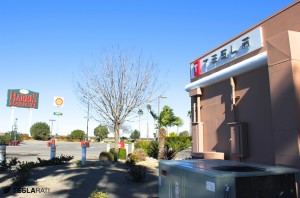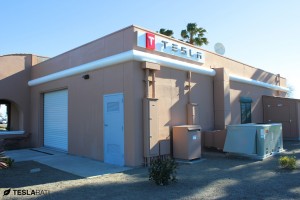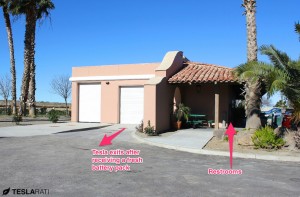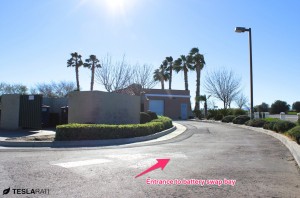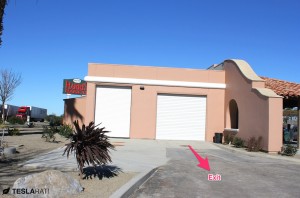News
Tesla shuts down battery swap program in favor of Superchargers, for now
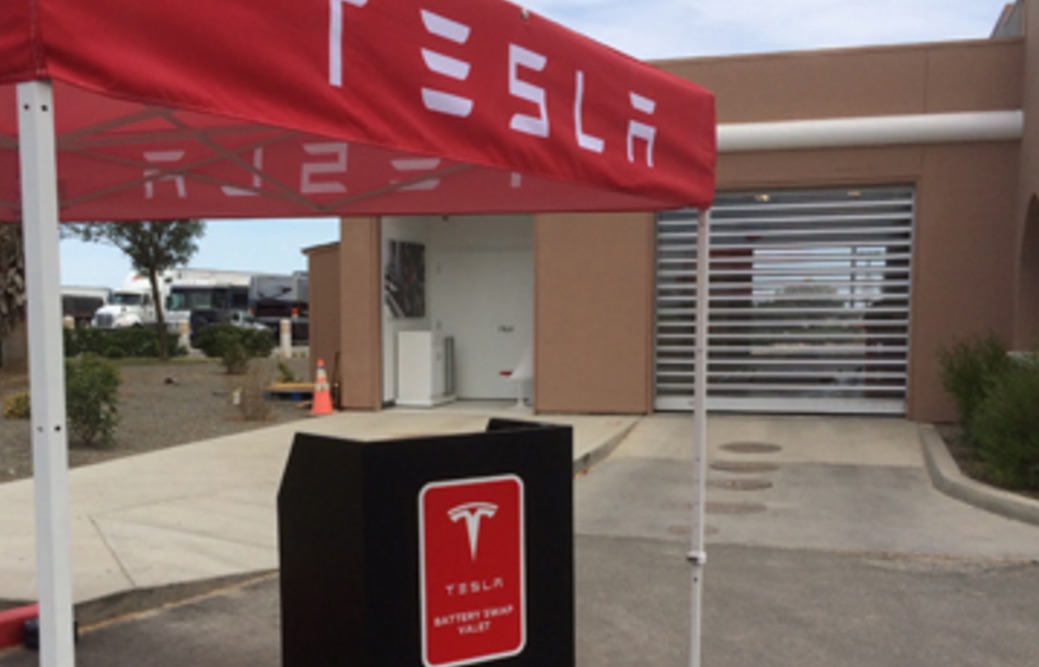
Tesla’s battery swap station near the Harris Ranch Supercharger station in Coalinga, CA seems to have been shut down, at least for now. What started out as a company vision to recharge Tesla vehicles in the same amount of time, if not quicker, as refueling a gas vehicle, turned into a pilot program that saw little to no fanfare.
Now, three years after Tesla first demonstrated the ability to quickly swap out the floor-mounted battery on a Model S and replace it with a fully charged battery pack, the company has seemingly closed the pilot program in favor of expanding its global network of Superchargers.
The news comes from a Tesla owner who had been following the development of the battery swap station off Interstate 5 (I-5) since its first debut. TeslaOwner accounts on their blog the experience with using Tesla’s battery swap program.
![Battery Swap station at Harris Ranch [Credit: TeslaOwner]](http://www.teslarati.com/wp-content/uploads/2014/12/141222enteringswap.jpg)
Battery Swap station at Harris Ranch [Credit: TeslaOwner]
TeslaOwner described the battery swap process as being a mix of machine and human. Any automation that occurred during the exchange was augmented by humans. Swap time was, on average, seven minutes. There was some trepidation that, upon returning the battery, a driver would receive a different battery with more accumulated mileage on it. Onboard technology did not recognize the swap and assumed that the original trip totals were continuing.
“Presently the Battery Swap Program is not accepting any new requests for appointments.”
Since experiencing the battery swap last July, TeslaOwner tells us that the same station has remained relatively quiet and “looked quite closed” each time they’ve driven by the station which appeared to have no activity.
This prompted them to inquire with Tesla about scheduling an appointment for another battery swap. According to TeslaOwner, they received a response from the Service Manager for the battery swap station, indicating that Tesla is no longer taking requests for appointments. “Presently the Battery Swap Program is not accepting any new requests for appointments.”
The viability of battery swaps moving forward
The Tesla proprietary charging station service was projected to be able to support both battery pack swaps as well as fast recharging of the Tesla Model S and Model X electric vehicle battery packs. By December 2014, 18 months after the original announcement, no battery swapping stations had yet opened to the public. Then a single battery-swap station was opened in California as a pilot project, where only invited Model S owners could do battery swaps by appointment, to assess technical and economic aspects of the service. Demand for the priced service would be used to determine whether the company would fully commercialize battery swapping stations more generally.
Photos captured of the Tesla battery swap station at Harris Ranch from December, 2014
By June 2015, the company had indicated that the battery swapping capability was no longer a significant part of Tesla’s plans for on-road energy replacement for their vehicles. Tesla’s standardization of car and the swapping stations alongside battery and battery fasteners prohibited other EV car owners from utilizing the battery swap station. For battery swapping to grow, the following conditions might need to be considered:
- Find strategic locations for battery swapping;
- Use alternative energy onsite to recharge batteries;
- Draw upon grid electricity when it is off-peak, cheapest, or when the more environmental energy generation is available;
- Assure customers that swapped batteries have comparable life expectancy in relation to the original;
- Incorporate fleet vehicles to reduce battery swapping costs overall.
The Tesla battery swap program doesn’t receive much press these days, given the news about the impending SolarCity merger and glass roof tiles, among the other constant Tesla technological innovations. Work on accelerating the rollout of Supercharger stations ahead of the Model 3 coming to market next year seems most critical. Moreover, regular Tesla owners at this moment in time don’t really seem to find the battery swap option as attractive as the Supercharger.
Of course, speculation continues to swirl. Tesla recently hired Audi’s North America commercial account manager to lead a new B2B push for Tesla in “fleet management, rental, government/public sectors & corporate enterprises.” Large commercial fleets of Tesla vehicles could change many aspects of the way that Tesla provides services, including a revisit to the battery swap with special, private fleet stations.

Elon Musk
SpaceX issues statement on Starship V3 Booster 18 anomaly
The incident unfolded during gas-system pressure testing at the company’s Massey facility in Starbase, Texas.

SpaceX has issued an initial statement about Starship Booster 18’s anomaly early Friday. The incident unfolded during gas-system pressure testing at the company’s Massey facility in Starbase, Texas.
SpaceX’s initial comment
As per SpaceX in a post on its official account on social media platform X, Booster 18 was undergoing gas system pressure tests when the anomaly happened. Despite the nature of the incident, the company emphasized that no propellant was loaded, no engines were installed, and personnel were kept at a safe distance from the booster, resulting in zero injuries.
“Booster 18 suffered an anomaly during gas system pressure testing that we were conducting in advance of structural proof testing. No propellant was on the vehicle, and engines were not yet installed. The teams need time to investigate before we are confident of the cause. No one was injured as we maintain a safe distance for personnel during this type of testing. The site remains clear and we are working plans to safely reenter the site,” SpaceX wrote in its post on X.
Incident and aftermath
Livestream footage from LabPadre showed Booster 18’s lower half crumpling around the liquid oxygen tank area at approximately 4:04 a.m. CT. Subsequent images posted by on-site observers revealed extensive deformation across the booster’s lower structure. Needless to say, spaceflight observers have noted that Booster 18 would likely be a complete loss due to its anomaly.
Booster 18 had rolled out only a day earlier and was one of the first vehicles in the Starship V3 program. The V3 series incorporates structural reinforcements and reliability upgrades intended to prepare Starship for rapid-reuse testing and eventual tower-catch operations. Elon Musk has been optimistic about Starship V3, previously noting on X that the spacecraft might be able to complete initial missions to Mars.
Investor's Corner
Tesla analyst maintains $500 PT, says FSD drives better than humans now
The team also met with Tesla leaders for more than an hour to discuss autonomy, chip development, and upcoming deployment plans.

Tesla (NASDAQ:TSLA) received fresh support from Piper Sandler this week after analysts toured the Fremont Factory and tested the company’s latest Full Self-Driving software. The firm reaffirmed its $500 price target, stating that FSD V14 delivered a notably smooth robotaxi demonstration and may already perform at levels comparable to, if not better than, average human drivers.
The team also met with Tesla leaders for more than an hour to discuss autonomy, chip development, and upcoming deployment plans.
Analysts highlight autonomy progress
During more than 75 minutes of focused discussions, analysts reportedly focused on FSD v14’s updates. Piper Sandler’s team pointed to meaningful strides in perception, object handling, and overall ride smoothness during the robotaxi demo.
The visit also included discussions on updates to Tesla’s in-house chip initiatives, its Optimus program, and the growth of the company’s battery storage business. Analysts noted that Tesla continues refining cost structures and capital expenditure expectations, which are key elements in future margin recovery, as noted in a Yahoo Finance report.
Analyst Alexander Potter noted that “we think FSD is a truly impressive product that is (probably) already better at driving than the average American.” This conclusion was strengthened by what he described as a “flawless robotaxi ride to the hotel.”
Street targets diverge on TSLA
While Piper Sandler stands by its $500 target, it is not the highest estimate on the Street. Wedbush, for one, has a $600 per share price target for TSLA stock.
Other institutions have also weighed in on TSLA stock as of late. HSBC reiterated a Reduce rating with a $131 target, citing a gap between earnings fundamentals and the company’s market value. By contrast, TD Cowen maintained a Buy rating and a $509 target, pointing to strong autonomous driving demonstrations in Austin and the pace of software-driven improvements.
Stifel analysts also lifted their price target for Tesla to $508 per share over the company’s ongoing robotaxi and FSD programs.
Elon Musk
SpaceX Starship Version 3 booster crumples in early testing
Photos of the incident’s aftermath suggest that Booster 18 will likely be retired.

SpaceX’s new Starship first-stage booster, Booster 18, suffered major damage early Friday during its first round of testing in Starbase, Texas, just one day after rolling out of the factory.
Based on videos of the incident, the lower section of the rocket booster appeared to crumple during a pressurization test. Photos of the incident’s aftermath suggest that Booster 18 will likely be retired.
Booster test failure
SpaceX began structural and propellant-system verification tests on Booster 18 Thursday night at the Massey’s Test Site, only a few miles from Starbase’s production facilities, as noted in an Ars Technica report. At 4:04 a.m. CT on Friday, a livestream from LabPadre Space captured the booster’s lower half experiencing a sudden destructive event around its liquid oxygen tank section. Post-incident images, shared on X by @StarshipGazer, showed notable deformation in the booster’s lower structure.
Neither SpaceX nor Elon Musk had commented as of Friday morning, but the vehicle’s condition suggests it is likely a complete loss. This is quite unfortunate, as Booster 18 is already part of the Starship V3 program, which includes design fixes and upgrades intended to improve reliability. While SpaceX maintains a rather rapid Starship production line in Starbase, Booster 18 was generally expected to validate the improvements implemented in the V3 program.
Tight deadlines
SpaceX needs Starship boosters and upper stages to begin demonstrating rapid reuse, tower catches, and early operational Starlink missions over the next two years. More critically, NASA’s Artemis program depends on an on-orbit refueling test in the second half of 2026, a requirement for the vehicle’s expected crewed lunar landing around 2028.
While SpaceX is known for diagnosing failures quickly and returning to testing at unmatched speed, losing the newest-generation booster at the very start of its campaign highlights the immense challenge involved in scaling Starship into a reliable, high-cadence launch system. SpaceX, however, is known for getting things done quickly, so it would not be a surprise if the company manages to figure out what happened to Booster 18 in the near future.
